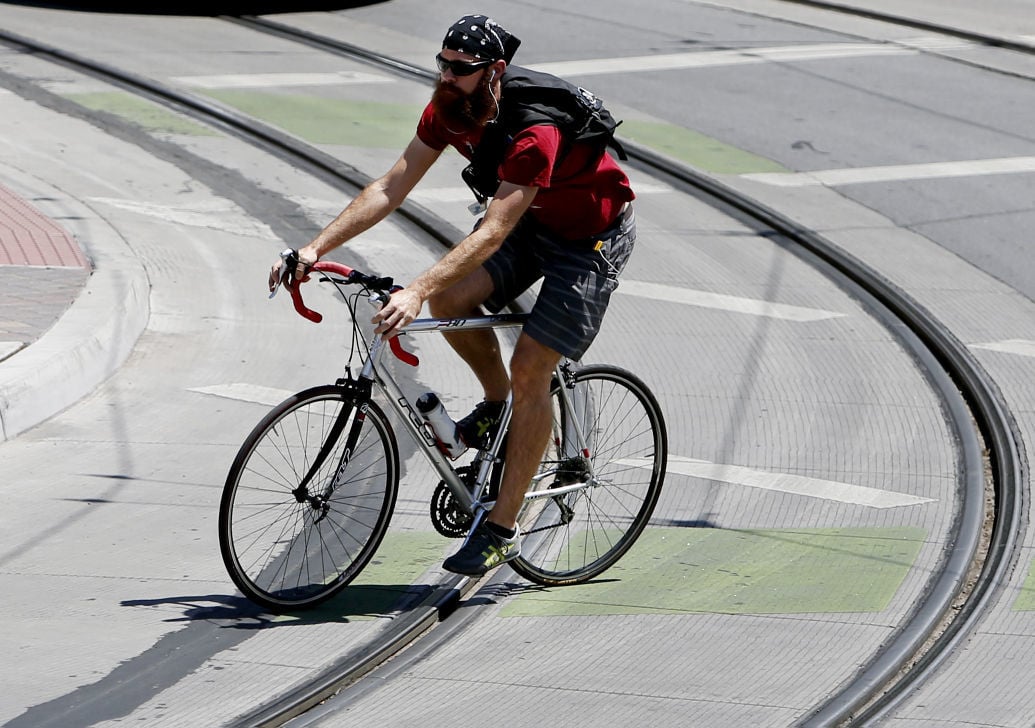If you hurt yourself while riding your bicycle across trolley tracks, it’s probably your own fault.
At least that’s the conclusion of the 9th Circuit Court of Appeals in ruling against a woman who sued after being thrown from her bike when the tire got stuck in the tracks of ĂŰčÖÖ±˛Ąâ€™s Sun Link streetcar system.
In a unanimous decision Wednesday, the three-judge panel said it is irrelevant whether the city could have chosen a different design for the tracks that was less likely to cause problems for bicyclists. The judges said as long as the one chosen by ĂŰčÖÖ±˛Ą conformed to “applicable design and engineering standards,” the city was entitled to immunity.
Anyway, the judges said, bicyclists were warned of the hazard.
According to court records, Megan McKay, then a student at the University of ĂŰčÖÖ±˛Ą, was thrown from her bicycle in 2013 while riding on East University Boulevard after dark when her front tire fell into a streetcar track embedded in the pavement. The rails run through the center of the street, to the left of the bike path, forcing eastbound cyclists to cross the track when passing through the intersection.
People are also reading…
McKay said the tire, seizing in the gap in the rails, brought her bike to an abrupt and unexpected stop, throwing her from the bike onto the sidewalk where she struck her head and shoulder. She claimed serious and permanent injuries to her face, teeth, shoulder and collarbone.
In filing suit, McKay said the tracks should have been installed with “protective fillers” in the gaps to protect bicyclists. She also said the area was not properly lighted and that there was insufficient warning to bicyclists.
A trial judge threw out the case, saying the city is entitled to immunity. That sent the issue to the appellate court.
The appellate judges pointed out that in ĂŰčÖÖ±˛Ą government agencies and employees are immune from lawsuit for any injury “raising out of a plan or design for construction or maintenance” of roads.
There are two conditions. First, that design has to be “prepared in conformance with generally accepted engineering or design standards in effect at the time.” And second, there must be “reasonably adequate warning … which would allow the public to take suitable precautions.”
All that occurred here, the court concluded.
At one point the city was looking at something called a “girder rail,” which has a 1.5-inch gap between the rail and the street. But that was rejected because it was not manufactured in the U.S. and therefore did not qualify for federal stimulus funds.
At a 2010 meeting of the Transit Working Group of the Regional Transportation Authority, there was a discussion about two alternatives, a “block rail” and a “T-rail.” According to the minutes of the meeting, it was mentioned that the T-rail “can cause increased gapping in pavement which is of concern for cyclists.”
Less than a year later, project managers informed the RTA they were going to go ahead with that T-rail design, saying it “meets operational standards, is proven and offers approximately $3.5 million in savings compared to block rail.”
But the appellate judges said the city’s decision to use the T-rail track “does not erase the benefits the Pima County voters perceived when they approved the streetcar project in 2006.”
The judges also said there was evidence that the design met generally accepted standards and it got the approval of the Federal Transit Administration.
The judges said even if a jury could conclude the T-rail presented an “unreasonably dangerous” hazard, that was overcome by evidence of “reasonably adequate warnings,” including pavement markings, lighting at the intersection, a bike island that exceeded industry standards, and a black-and-yellow sign that reads “Tracks in Pavement.” They also rejected a claim by McKay’s hired expert witness that the street markings were “faded from age and abrasion,” citing evidence that the marking had just been installed and had reflective beads.
John McKay, the bicyclist’s attorney and her father , would not comment on the ruling other than to say he will ask the appellate court for a rehearing.
There was no immediate response from city officials to provide recent data on incidents involving bicycles and the streetcar line.
But in 2014, the Living Streets Alliance published a report finding 86 incidents during an 18-month period. That report said all crashes involved bicyclists hitting the pavement after getting wheels caught in the tracks.

























